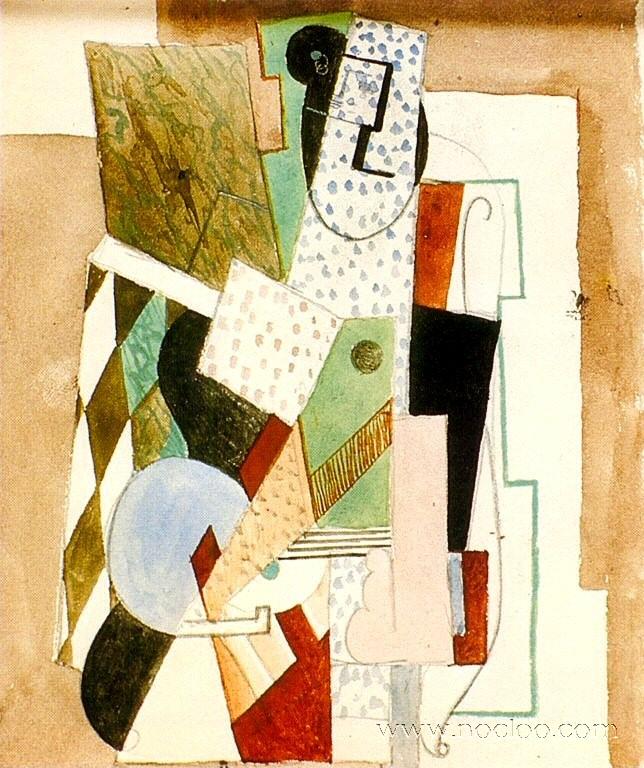


Forms are generally compact and dense in the centre of the Analytical Cubist painting, growing larger as they diffuse toward the edges of the canvas, as in Picasso's "Portrait of Ambroise Vollard". Picassos Paintings, Watercolors, Drawings & Sculpture: Synthetic Cubism - 1913-1916. These planes appear to ascend the surface of the canvas rather than to recede in depth. The monochromatic colour scheme was suited to the presentation of complex, multiple views of the object, which was now reduced to overlapping opaque and transparent planes. Study with Quizlet and memorize flashcards containing terms like Synthetic Cubism, Still Life with Chair Caning by Pablo Picasso, Tavern by Pablo Picasso. Colour schemes were simplified, tending to be nearly monochromatic (hues of tan, brown, gray, cream, green, or blue preferred) in order not to distract the viewer from the artist's primary interest-the structure of form itself. Right-angle and straight-line construction were favoured, though occasionally some areas of the painting appeared sculptural, as in Picasso's "Girl with a Mandolin" (1910). his transition from analytical to synthetic cubism, and that it includes. Paintings executed during this period showed the breaking down, or analysis, of form. catalogue of the Museum of Modern Art (MOMA) exhibition Picasso and Braque.4. Picasso's work can thus be seen as simultaneously warning against the absurdity of modern life while also delighting in life's simple pleasures.The period from 1910 to 1912 is referred to as Analytical Cubism. In an attempt to classify the revolutionary experiments made in cubism by Georges Braque, Pablo Picasso and Juan Gris, historians tend to divide cubism into two.

Along with the texts, the distorted, fragmented forms in this Cubist image allude to such conditions of modernity as the lack of coherent perspectives or meanings in a constantly changing world. A number of influences and circumstances came together around 1906 that led Picasso to abandon his Rose Period/Saltimbanque work. Later, collaged elements appear in the work, colour became more dominant, and the subject less fragmentedthis phase is labeled Synthetic Cubism.
++1913++18-08-2013+17-12-34+18-08-2013+17-12-34.jpg)
The texts add a political and social dimension to the image: they juxtapose newspaper articles referring to horrific events from the First Balkan war with stories of Parisian frivolity. This early phase is often referred to as Analytic Cubism. From about 1909 he worked with a French artist called Georges Braque and together they created a style of art referred to as Synthetic Cubism. Serving as a formal element, the newsprint also suggests the popular Parisian café activity of reading the paper while smoking and drinking. Cubism Written Assignment PABLO PICASSO & Synthetic Cubism Pablo Picasso (1881-1973), a Spanish artist, is one of the most well known artists of the 20th Century. These abstract, fragmented elements all appear to rest on a blue table in front of a wall with diamond-patterned wallpaper and newsprint. Retreat from abstraction During this phase both artists retreated from the verge of total abstraction they had reached in their late Analytic Cubist paintings. In La Bouteille de Suze, Picasso used cut fragments of newsprint, wallpaper, and construction paper, as well as gouache and charcoal, to suggest a liquor bottle with a label and, on the left, a glass and an ashtray with cigarette and smoke. Papier coll was a central medium in the second phase of Braque’s and Picasso’s joint Cubist investigations commonly known as Synthetic Cubism. The movement was pioneered by Pablo Picasso and Georges Braque, and joined by Jean Metzinger, Albert Gleizes, Robert Delaunay, Henri Le Fauconnier. Pablo Picasso's La Bouteille de Suze is a key image of the late Synthetic Cubism developed by Georges Braque, Juan Gris, and Picasso, in which the artists synthesized separate elements from real life in their pictures to suggest objects and environments.


 0 kommentar(er)
0 kommentar(er)
